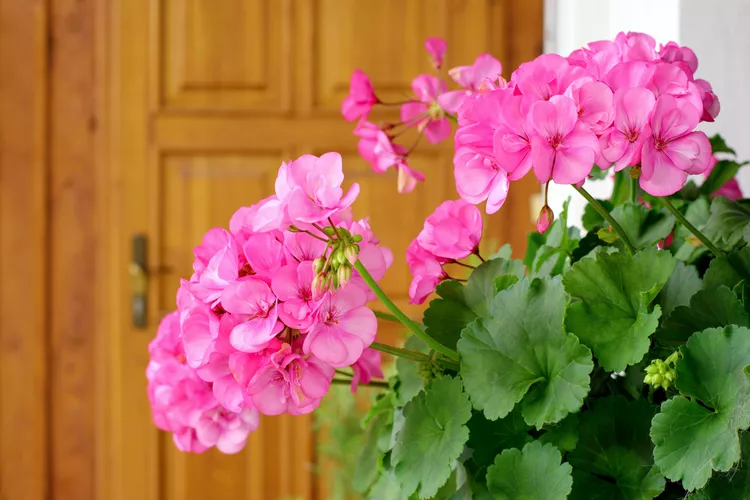Geraniums, also known as pelargoniums, are colorful plants that are favorites for growing in containers and garden beds. At the end of the growing season, you may be wondering, "Are geraniums perennial?" so you can continue enjoying them next year. The answer is that several types such as zonal, ivy, and regal geraniums are perennial plants that can continue growing for many years. However, they are frost-tender plants, meaning they won't survive freezing temperatures. But it's possible to overwinter geraniums indoors if you'd like to keep them going from year to year in colder climates. Use these tips to get started.
Overwintering Geranium Plants Indoors
To overwinter geraniums year after year, you'll need to protect them from freezing temperatures. The easiest way to do that is to bring them indoors. Follow these steps to keep your geraniums going until the weather warms up again in spring.
- Bring plants inside before frost. Too much cold can cause geraniums to go into shock and die. Lorene Edwards Forkner, a gardener, speaker, and author of Color In and Out Of the Garden, brings her geranium containers inside to her basement when the first hard freeze or snow is forecasted in her area in the Pacific Northwest region of the country.
- Check for pests. If you spot any hitchhiking insects on your geraniums, spray them off with a strong stream of water from the hose before taking them indoors. It's also a good idea to keep your geraniums in a spot away from other houseplants for a couple of weeks in case any pests are still present.
- Repot if necessary. Some of Forkner's geraniums are in huge containers, so she repots them into smaller pots during September in preparation to move them indoors when winter begins.
- Water sparingly. When Forkner puts her geraniums into her basement, she encourages the plants to go into natural dormancy by only watering sparingly until the spring. "Barely moisten the soil, because that dry, dark, cool [atmosphere] tells the plant to just rest, just go to bed,” she explains. As for how often to water, her tip is to water about once a month on holidays. "So if you bring it in October, then water it on Thanksgiving, Christmas, Martin Luther King Day, Valentine's Day, St. Patrick's Day, and by that time, you're probably where you could start introducing it to outdoor temperatures again."
Take Geranium Cuttings
Another way to keep your geranium plants going from year to year is to take cuttings of your plants to bring indoors. You can root the cuttings and grow them throughout the winter. Beth Syphers, founder of Crowley House Flower Farm, takes cuttings starting in September. She goes out to her fields with garden shears and a plastic bag with a little water in it to keep the cuttings hydrated before bringing them inside her home.
Syphers uses the following steps to root her geranium cuttings:
- Fill six-cell garden trays or other small containers with moist potting soil.
- Cut 3- to 4-inch stems of new growth from healthy geranium plants.
- Place the cuttings in a plastic bag with some water.
- Use a pencil to make a small hole in the potting soil for each cutting.
- Strip off a few of the bottom leaves on each cutting and dip the cut end and lowest leaf node into a dish of rooting hormone powder or cinnamon, which is a natural type of rooting hormone.
- Carefully place each stem into a hole in the potting soil.
- Water well and cover the geranium cuttings with domes. “A dome can be anything from a water bottle cut in half to an actual dome tray," Syphers says.
- Place cuttings in a brightly lit spot out of direct sun and keep soil moist but not soggy.
- After two weeks, lift the domes and check for rooting by gently tugging on the cutting to see if there's resistance. If not, check again in a week.
- Once your cuttings have rooted, remove the domes.
- After a few days, move cuttings into small individual pots to give them more space to develop roots.
Moving Overwintered Geraniums Outdoors Again
When temperatures hit 50ºF in spring, start to bring overwintered geraniums outside to acclimate. After being in a cool, low-lit place for the winter, bringing them outside can shock them a bit, so start out slowly with just a couple hours a day and gradually increase the time each day. If temperatures will drop below 40ºF, take your geraniums back inside until it warms up again.
Forkner puts her geraniums outdoors in a sheltered spot "where they can be outside, but not truly exposed to wind and rain or late frost. And then after a couple of weeks of that, they're probably fine to go back to where they sit in the garden.” Usually, by the time you're past your area's last frost date, your geraniums should be adjusted to outdoor conditions again.




















